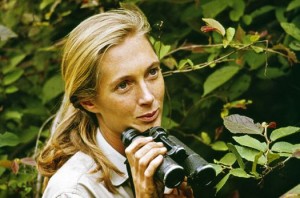 As a child I can vividly remember thumbing through old National Geographic magazines, living vicariously through the adventures of Dr. Jane Goodall. In the 1980s, long before online giants Amazon or Barnes and Noble became popular, I would visit both my school library and the local city-owned branch on an almost daily basis. I was able to read about Jane’s explorations of the forests of Gombe and the chimpanzee ambassadors who greeted here as a friend. Oh to live life amongst the chimps must have been paradise.
As a child I can vividly remember thumbing through old National Geographic magazines, living vicariously through the adventures of Dr. Jane Goodall. In the 1980s, long before online giants Amazon or Barnes and Noble became popular, I would visit both my school library and the local city-owned branch on an almost daily basis. I was able to read about Jane’s explorations of the forests of Gombe and the chimpanzee ambassadors who greeted here as a friend. Oh to live life amongst the chimps must have been paradise.
I soon understood that chimpanzees were very much like humans, one may say too much like us. Dr. Goodall truly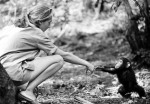 redefined man proving that chimpanzees were also tool makers, exhibited similar behaviors previously only associated with humans, and ate meat. In addition, Jane’s beloved chimps had a dark side, one filled with cruelty, violence, and murder. Did her observations into this secret simian society actually turn interest away? The answer is a simple no. As humans we are very much enthralled with ourselves, and finding another member of the animal kingdom that was human-like captivated us even more.
redefined man proving that chimpanzees were also tool makers, exhibited similar behaviors previously only associated with humans, and ate meat. In addition, Jane’s beloved chimps had a dark side, one filled with cruelty, violence, and murder. Did her observations into this secret simian society actually turn interest away? The answer is a simple no. As humans we are very much enthralled with ourselves, and finding another member of the animal kingdom that was human-like captivated us even more.
Last year, in 2010, marked the fiftieth anniversary, yes fifty years, of Jane Goodall’s Gombe chimp research study. To share her journey, Dr.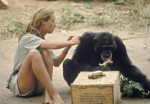 Goodall has authored many books regarding her observations at Gombe. In addition, she has also written books for children, regarding food and our environment, and the plight of endangered species and those incredible individuals, much like Dr. Jane herself, who dedicate their lives to save them. Recently, Jane’s magnificent career was chronicled in a film entitled Jane’s Journey. Available for viewing for only one night, 29 September, in 500 theaters, the film was accompanied by a live satellite feed from none other than Jane herself. I don’t think I have to tell you how excited I was to be one of the special select individuals to get to once again share her adventures.
Goodall has authored many books regarding her observations at Gombe. In addition, she has also written books for children, regarding food and our environment, and the plight of endangered species and those incredible individuals, much like Dr. Jane herself, who dedicate their lives to save them. Recently, Jane’s magnificent career was chronicled in a film entitled Jane’s Journey. Available for viewing for only one night, 29 September, in 500 theaters, the film was accompanied by a live satellite feed from none other than Jane herself. I don’t think I have to tell you how excited I was to be one of the special select individuals to get to once again share her adventures.
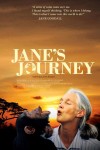 Jane’s Journey was a wonderful trip from Dr. Goodall’s early years at Gombe to her endless campaign for conservation and hope. Unlike other programs about Jane Goodall, this particular piece offered a unique glimpse into her personal life, showing us the daughter, wife, and mother behind the conservation powerhouse we all know as Dr. Jane Goodall. Through the trials and tribulations that came with research of this nature, Jane has acquired quite the international following of both young and old that seem to hang on her every word; I know I certainly do.
Jane’s Journey was a wonderful trip from Dr. Goodall’s early years at Gombe to her endless campaign for conservation and hope. Unlike other programs about Jane Goodall, this particular piece offered a unique glimpse into her personal life, showing us the daughter, wife, and mother behind the conservation powerhouse we all know as Dr. Jane Goodall. Through the trials and tribulations that came with research of this nature, Jane has acquired quite the international following of both young and old that seem to hang on her every word; I know I certainly do.
So what does this all mean for me, and why am I sharing this with you? One of the things I absolutely adore about Dr. Jane is that no matter the situation she always maintains her composure and poise, proving that to make a positive impact one can never fight fire with fire. It is so easy to faultier, losing sight of ones goals and changing personal values and ethics to what others want and expect, but this has never been the case for Jane. I respect Dr. Goodall as a scientist, conservationist, and a woman; she is the epitome of all that I aspire to be in my own career.
Recently, I was in the press for some of my accomplishments with my own research. I was overjoyed to find that all of my hard work was now being shared with others who were outside of my direct group of friends and family. I felt confident that by sharing my passion for wildlife and conservation others would fall in love too. So you can probably imagine my shock as the initial attack came from a particular group of animal rights activists who condemned me for the non-invasive work I was doing to better understand the reproductive physiology in one magnificent creature. I cannot describe my hurt from the horrible words hurling my way from people who did not know me at all. I was insulted, degraded, and threatened, yes physically threatened, by people claiming to be peaceful, kind, and loving. As I sat at my desk I tried to think of Dr. Jane’s encouraging words that echoed on the big screen not two days earlier. And as if by some kind of otherworldly intervention I found what I was looking for in an interview by Jane earlier this year. When SciGuy, Eric Berger, asked Jane about her stance on zoos, and research in such places, Dr. Goodall stated, “At the other end of the extreme you get five-foot by five-foot cages in medical research labs in very sophisticated countries including the United States and you get very bad zoos and circuses. Then you get the really good zoos which have large enclosed areas, with enriched environments and a group of chimps together, keepers who love them and understand them and an adoring public. Then I say suppose you were a chimp, and that’s what some of these animal rights people can’t get their minds around, it’s what they think is best for the chimp. I want people to think about what the chimp would prefer. So if you’re a chimp, your best choices may be to be in a secure place in the wild, or a really good zoo. None of the other options are really of any use. This kind of idea that any kind of wild is always good is not right.” Thank you once again Jane, my hero.
I continued my path of redemption by re-reading exerts from Dr. Goodall’s most recent book Hope for Animals and Their World. As I fingered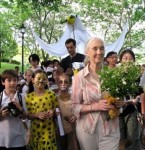 through this book I slowly regained my feeling of worth page by page. I am proud to say that I work with some of the most intelligent, passionate, and talented scientists in the world. If it were not for the captive breeding and reintroduction projects with endangered, sometimes almost extinct, species like the black-footed ferret, kakapo, Caspian horse, black robin, and the American burying beetle, to name a few, these creatures would only remain as ghostly images in history books. How lucky I am to work with those passionate individuals who have acted to save some amazing creatures! How incredible it is to follow in the huge footsteps laid before me by wildlife biologist like Dr. JoGayle Howard, Dr. Devra Kleiman, and of course Dr. Jane Goodall.
through this book I slowly regained my feeling of worth page by page. I am proud to say that I work with some of the most intelligent, passionate, and talented scientists in the world. If it were not for the captive breeding and reintroduction projects with endangered, sometimes almost extinct, species like the black-footed ferret, kakapo, Caspian horse, black robin, and the American burying beetle, to name a few, these creatures would only remain as ghostly images in history books. How lucky I am to work with those passionate individuals who have acted to save some amazing creatures! How incredible it is to follow in the huge footsteps laid before me by wildlife biologist like Dr. JoGayle Howard, Dr. Devra Kleiman, and of course Dr. Jane Goodall.
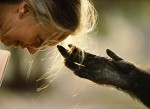 I continue to be enamored by Dr. Goodall. Still to this day an autographed picture of Jane adorns my office. That picture continues to be a source of inspiration and a reminder to never give up hope. At 77 years of age Dr. Jane travels the world 300 days a year to spread her message of hope and encouragement. Through the Jane Goodall Institute and Roots & Shoots, Jane and her colleagues empower and educate, working hand in hand with others to ensure that what we have today will be here for generations to come. I cannot thank you enough for your bravery and tireless campaign, Dr. Jane. You are the very reason a little girl dreamed that one day she too could travel the world and study such amazing creatures; you do not give up and neither shall I.
I continue to be enamored by Dr. Goodall. Still to this day an autographed picture of Jane adorns my office. That picture continues to be a source of inspiration and a reminder to never give up hope. At 77 years of age Dr. Jane travels the world 300 days a year to spread her message of hope and encouragement. Through the Jane Goodall Institute and Roots & Shoots, Jane and her colleagues empower and educate, working hand in hand with others to ensure that what we have today will be here for generations to come. I cannot thank you enough for your bravery and tireless campaign, Dr. Jane. You are the very reason a little girl dreamed that one day she too could travel the world and study such amazing creatures; you do not give up and neither shall I.